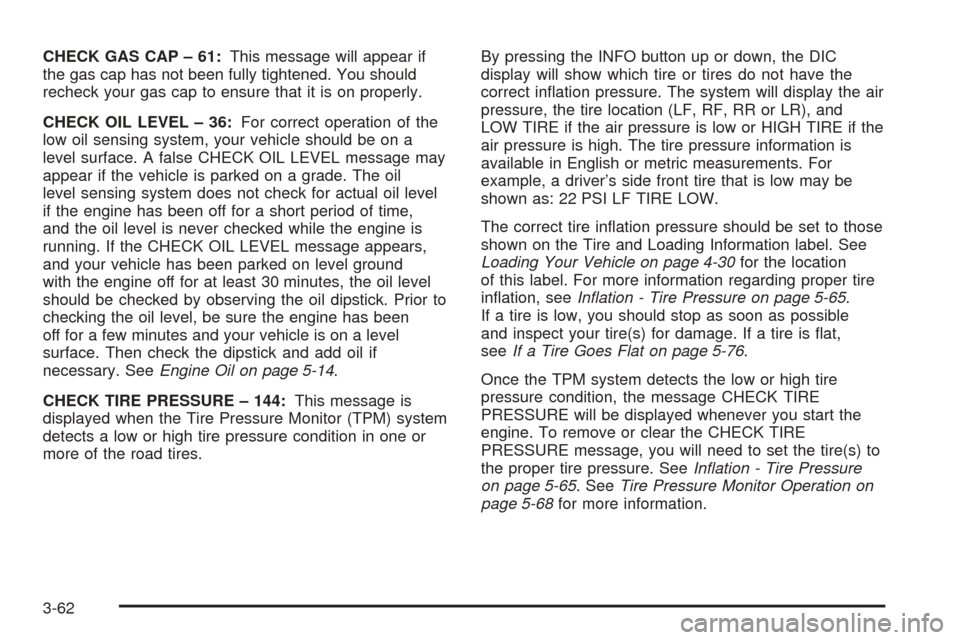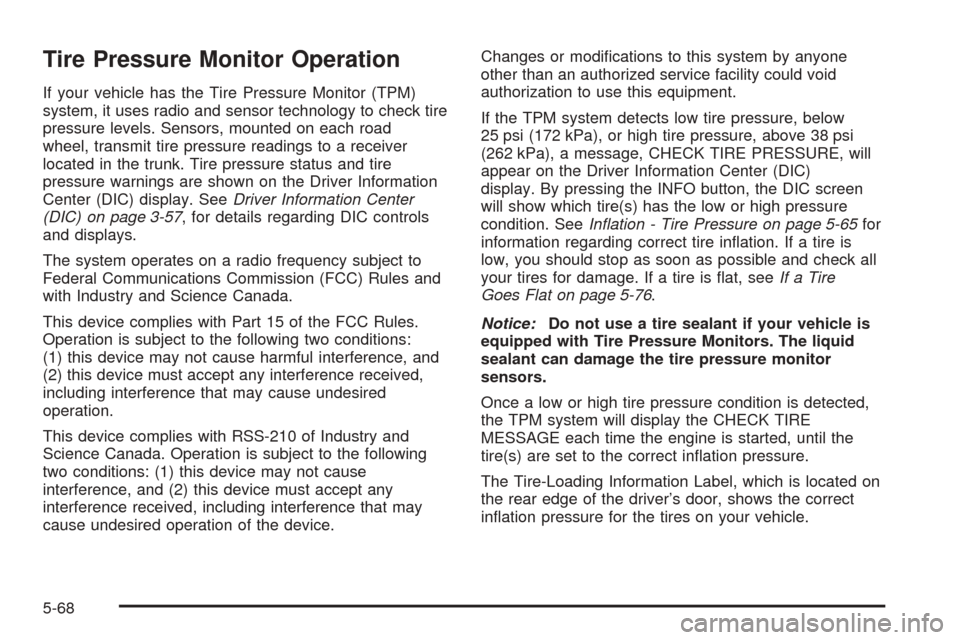run flat CADILLAC DEVILLE 2005 8.G Owners Manual
[x] Cancel search | Manufacturer: CADILLAC, Model Year: 2005, Model line: DEVILLE, Model: CADILLAC DEVILLE 2005 8.GPages: 420, PDF Size: 2.63 MB
Page 182 of 420

CHECK GAS CAP – 61:This message will appear if
the gas cap has not been fully tightened. You should
recheck your gas cap to ensure that it is on properly.
CHECK OIL LEVEL – 36:For correct operation of the
low oil sensing system, your vehicle should be on a
level surface. A false CHECK OIL LEVEL message may
appear if the vehicle is parked on a grade. The oil
level sensing system does not check for actual oil level
if the engine has been off for a short period of time,
and the oil level is never checked while the engine is
running. If the CHECK OIL LEVEL message appears,
and your vehicle has been parked on level ground
with the engine off for at least 30 minutes, the oil level
should be checked by observing the oil dipstick. Prior to
checking the oil level, be sure the engine has been
off for a few minutes and your vehicle is on a level
surface. Then check the dipstick and add oil if
necessary. SeeEngine Oil on page 5-14.
CHECK TIRE PRESSURE – 144:This message is
displayed when the Tire Pressure Monitor (TPM) system
detects a low or high tire pressure condition in one or
more of the road tires.By pressing the INFO button up or down, the DIC
display will show which tire or tires do not have the
correct in�ation pressure. The system will display the air
pressure, the tire location (LF, RF, RR or LR), and
LOW TIRE if the air pressure is low or HIGH TIRE if the
air pressure is high. The tire pressure information is
available in English or metric measurements. For
example, a driver’s side front tire that is low may be
shown as: 22 PSI LF TIRE LOW.
The correct tire in�ation pressure should be set to those
shown on the Tire and Loading Information label. See
Loading Your Vehicle on page 4-30for the location
of this label. For more information regarding proper tire
in�ation, seeIn�ation - Tire Pressure on page 5-65.
If a tire is low, you should stop as soon as possible
and inspect your tire(s) for damage. If a tire is �at,
seeIf a Tire Goes Flat on page 5-76.
Once the TPM system detects the low or high tire
pressure condition, the message CHECK TIRE
PRESSURE will be displayed whenever you start the
engine. To remove or clear the CHECK TIRE
PRESSURE message, you will need to set the tire(s) to
the proper tire pressure. SeeIn�ation - Tire Pressure
on page 5-65. SeeTire Pressure Monitor Operation on
page 5-68for more information.
3-62
Page 340 of 420

Tire Pressure Monitor Operation
If your vehicle has the Tire Pressure Monitor (TPM)
system, it uses radio and sensor technology to check tire
pressure levels. Sensors, mounted on each road
wheel, transmit tire pressure readings to a receiver
located in the trunk. Tire pressure status and tire
pressure warnings are shown on the Driver Information
Center (DIC) display. SeeDriver Information Center
(DIC) on page 3-57, for details regarding DIC controls
and displays.
The system operates on a radio frequency subject to
Federal Communications Commission (FCC) Rules and
with Industry and Science Canada.
This device complies with Part 15 of the FCC Rules.
Operation is subject to the following two conditions:
(1) this device may not cause harmful interference, and
(2) this device must accept any interference received,
including interference that may cause undesired
operation.
This device complies with RSS-210 of Industry and
Science Canada. Operation is subject to the following
two conditions: (1) this device may not cause
interference, and (2) this device must accept any
interference received, including interference that may
cause undesired operation of the device.Changes or modi�cations to this system by anyone
other than an authorized service facility could void
authorization to use this equipment.
If the TPM system detects low tire pressure, below
25 psi (172 kPa), or high tire pressure, above 38 psi
(262 kPa), a message, CHECK TIRE PRESSURE, will
appear on the Driver Information Center (DIC)
display. By pressing the INFO button, the DIC screen
will show which tire(s) has the low or high pressure
condition. SeeIn�ation - Tire Pressure on page 5-65for
information regarding correct tire in�ation. If a tire is
low, you should stop as soon as possible and check all
your tires for damage. If a tire is �at, seeIf a Tire
Goes Flat on page 5-76.
Notice:Do not use a tire sealant if your vehicle is
equipped with Tire Pressure Monitors. The liquid
sealant can damage the tire pressure monitor
sensors.
Once a low or high tire pressure condition is detected,
the TPM system will display the CHECK TIRE
MESSAGE each time the engine is started, until the
tire(s) are set to the correct in�ation pressure.
The Tire-Loading Information Label, which is located on
the rear edge of the driver’s door, shows the correct
in�ation pressure for the tires on your vehicle.
5-68
Page 357 of 420

13. Tighten the wheel nuts �rmly in a crisscross
sequence as shown.
If your vehicle is equipped with wheel nut covers,
screw them on with your �ngers, then tighten
one-quarter turn with the wheel wrench.
Notice:Wheel covers will not �t on your compact
spare. If you try to put a wheel cover on the compact
spare, you could damage the cover or the spare.
Do not try to put a wheel cover on your compact spare
tire. It will not �t. Store the wheel cover and lug nut
caps in the trunk until you have the �at tire repaired
or replaced.
Storing a Flat or Spare Tire
and Tools
{CAUTION:
Storing a jack, a tire, or other equipment in the
passenger compartment of the vehicle could
cause injury. In a sudden stop or collision,
loose equipment could strike someone.
Store all these in the proper place.
After you have put the compact spare tire on your
vehicle, you will need to store the �at tire in your trunk.
Store the �at tire as far forward in the trunk as
possible. Store the jack and wheel wrench in their
compartment in the trunk. For storage, the jack must be
raised until the screw end is �ush with the edge of
the jack. 5-Wheel Nuts
8-Wheel Nuts
5-85
Page 419 of 420

Tires (cont.)
Chains.......................................................5-75
Changing a Flat Tire....................................5-77
Cleaning....................................................5-94
Compact Spare Tire.....................................5-86
If a Tire Goes Flat.......................................5-76
In�ation -- Tire Pressure...............................5-65
Inspection and Rotation................................5-69
Installing the Spare Tire................................5-80
Pressure Monitor Operation...........................5-68
Removing the Flat Tire.................................5-80
Removing the Spare Tire and Tools...............5-78
Storing a Flat or Spare Tire and Tools............5-85
Tire Sidewall Labelling..................................5-58
Tire Terminology and De�nitions....................5-62
Uniform Tire Quality Grading.........................5-72
Wheel Alignment and Tire Balance.................5-73
Wheel Replacement.....................................5-73
When It Is Time for New Tires......................5-70
Top Strap......................................................1-38
Top Strap Anchor Location...............................1-39
Towing
Recreational Vehicle.....................................4-35
Towing a Trailer..........................................4-37
Your Vehicle...............................................4-35
Traction
Continuous Variable Road Sensing
Suspension (CVRSS)................................4-10
Control System (TCS).................................... 4-8Traction (cont.)
Control System Warning Light.......................3-48
Transaxle
Fluid, Automatic...........................................5-21
Transaxle Operation, Automatic.........................2-28
Trip Computer
Oil Life Indicator..........................................3-79
Trip Odometer................................................3-43
Trunk............................................................2-12
Turn and Lane-Change Signals.......................... 3-8
Turn Signal/Multifunction Lever........................... 3-8
Twilight Sentinel
®............................................3-18
U
Ultrasonic Rear Parking Assist (URPA)...............3-26
Umbrella Holder..............................................2-51
Understanding Radio Reception.......................3-104
Uniform Tire Quality Grading............................5-72
V
Valet Lockout Switch.......................................2-21
Vehicle
Control........................................................ 4-5
Damage Warnings........................................... iv
Loading......................................................4-30
Symbols......................................................... iv
13